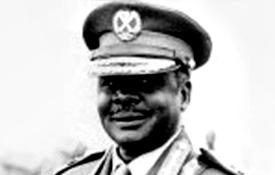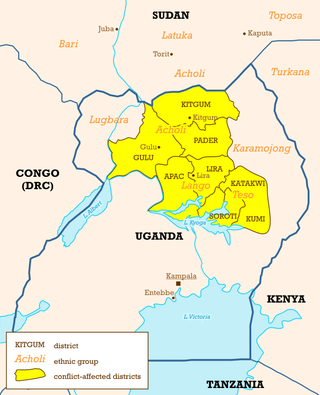Related Research Articles

In the aftermath of the Ugandan Civil War, Ugandan militant Joseph Kony formed the Lord's Resistance Army and waged an insurgency against the newly-installed president Yoweri Museveni. The stated goal was to establish a Christian state based on the Ten Commandments. Currently, there is low-level LRA activity in the eastern Democratic Republic of the Congo and the Central African Republic. Kony proclaims himself the "spokesperson" of God and a spirit medium.

The History of Uganda from 1979 to 1986 comprises the history of Uganda since the end of the dictatorship of Idi Amin. This period has seen the second rule of Milton Obote and the presidency of Yoweri Museveni since 1986, in which Ugandan politics have been dominated by the National Resistance Movement.
Joseph Rao Kony is a Ugandan militant who founded the Lord's Resistance Army (LRA), designated as a terrorist group by the United Nations Peacekeepers, the European Union, and various other governments.

Tito Lutwa Okello was an Ugandan military officer and politician. He was the eighth president of Uganda from 29 July 1985 until 26 January 1986.
The National Resistance Army (NRA), the military wing of the National Resistance Movement (NRM), was a rebel army that waged a guerrilla war, commonly referred to as the Ugandan Bush War or Luwero War, against the government of Milton Obote, and later that of Tito Okello. NRA was supported by Muammar Gaddafi.

The Holy Spirit Movement (HSM) is a spiritual/religious movement and Ugandan rebel group centered around founder Alice Lakwena (Auma). Alice, an ethnic Acholi, was purportedly directed to form the HSM by Lakwena, one of her spirits, in August 1986. The movement grew to adopt a military wing and waged a major but short-lived rebellion as part of the war in Uganda (1986–1994). It inspired Joseph Kony to begin his rebel group, the Lord's Resistance Army (LRA).

Alice Auma was an Acholi spirit-medium who, as the head of the Holy Spirit Movement (HSM), led a millennial rebellion against the Ugandan government forces of President Yoweri Museveni from August 1986 until November 1987. The primary spirit she purportedly channelled was that of a dead army officer called "Lakwena", meaning messenger, which the Acholi believe to be a manifestation of the Christian Holy Spirit. The combined persona of Alice Auma channelling the spirit Lakwena is often referred to as "Alice Lakwena". Auma's HSM was ultimately defeated in November 1987 by Ugandan forces led by Yoweri Museveni.

Betty Oyella Bigombe, also known as Betty Atuku Bigombe, is an Ugandan politician who served as the Senior Director for Fragility, Conflict, and Violence at the World Bank from 2014 to 2017. She was appointed in June 2014. From May 2011 until June 2014, she was the State Minister for Water Resources in the Uganda Cabinet. She was appointed on 27 May 2011. She concurrently served as the elected Member of Parliament (MP), representing Amuru District Women's Constituency. She resigned from the two appointments on 1 June 2014.
The Nairobi Agreement was a peace deal between the Ugandan government of Tito Okello and the National Resistance Army (NRA) rebel group led by Yoweri Museveni. The accords were signed in Nairobi, Kenya in December 1985.

The period from 1986 to 1994 of the Lord's Resistance Army insurgency is the early history of the ongoing insurgency of the Lord's Resistance Army (LRA) rebel group in Uganda, which has been described as one of the most under-reported humanitarian crises in the world. The Lord's Resistance Army was formed in early 1987 out of the conflict following the successful rebellion of the National Resistance Army (NRA), though remained a relative small group through the counterinsurgency of the NRA. As the peace talks initiated by Minister Betty Bigombe failed Sudanese support to the LRA intensified the conflict.

The start of the period 1994 to 2002 of the Lord's Resistance Army insurgency in northern Uganda saw the conflict intensifying due to Sudanese support to the rebels. There was a peak of bloodshed in the mid-1990s and then a gradual subsiding of the conflict. Violence was renewed beginning with the offensive by the Uganda People's Defence Force in 2002.
Justine Odong Latek was a Ugandan brigadier who served in the Uganda National Liberation Army (UNLA) during the Ugandan Bush War and later led the Uganda People's Democratic Army (UPDA) during the 1986–1994 war in Uganda.

David Oyite Ojok was a Ugandan military commander who held one of the leadership positions in the coalition between Uganda National Liberation Army and Tanzania People's Defence Force which removed strongman Idi Amin in 1979 and, until his death in a helicopter crash, served as the national army chief of staff with the rank of major general.

The Ugandan Bush War was a civil war fought in Uganda by the official Ugandan government and its armed wing, the Uganda National Liberation Army (UNLA), against a number of rebel groups, most importantly the National Resistance Army (NRA), from 1980 to 1986.
The military history of Uganda begins with actions before the conquest of the country by the British Empire. After the British conquered the country, there were various actions, including in 1887, and independence was granted in 1962. After independence, Uganda was plagued with a series of conflicts, most rooted in the problems caused by colonialism. Like many African nations, Uganda endured a series of civil wars and coup d'états. Since the 2000s in particular, the Uganda People's Defence Force has been active in peacekeeping operations for the African Union and the United Nations.
The Uganda People's Army (UPA) was a rebel group recruited primarily from the Iteso people of Uganda that was active between 1987 and 1992. The UPA was composed mostly of former soldiers in the special forces of the Uganda National Liberation Army and opposed the National Resistance Army (NRA) government of Yoweri Museveni, who took power in January 1986. Reaching a height after the widespread cattle raid by Karamojong in 1987, the UPA rebellion was eventually ended through the mediation of the Teso Commission.

The Lord's Resistance Army (LRA) is a Christian extremist organization which operates in northern Uganda, South Sudan, Sudan, the Central African Republic, and the Democratic Republic of the Congo. Its stated goal includes the establishment of multi-party democracy in a Uganda bound by the Ten Commandments.
StGiNU is an advocacy group formed in the beginning of 2005 by Ugandans living in the United Kingdom. At that time, the situation in the concentration camps in Northern Uganda was claiming lives more than cross fire casualties. In the same year 2005, the Ugandan World Health Organization reported that there were 5000 excess deaths per week due to camp conditions alone.

The Acholi people are a Nilotic ethnic group of Luo peoples, found in Magwi County in South Sudan and Northern Uganda, including the districts of Agago, Amuru, Gulu, Kitgum, Nwoya, Lamwo, Pader and Omoro District. The Acholi were estimated to number 2.3 million people and over 45,000 more were living in South Sudan in 2000.

From 1986 to 1994, a variety of rebel groups waged a civil war against the Ugandan government of President Yoweri Museveni. Most of the fighting took place in the country's north and east, although the western and central regions were also affected. The most important insurgent factions were the Uganda People's Democratic Army (UPDA), the Uganda People's Army (UPA), Alice Auma's Holy Spirit Movement (HSM), and Joseph Kony's army. Several smaller rebel factions and splinter groups of the larger movements waged their own campaigns; the rebels often clashed with each other. All belligerents, including the government, targeted civilians and committed human rights violations. In course of fighting that involved tens of thousands of troops, the Ugandan government was able to gradually defeat or contain most rebel factions. The operations in the north and east caused great destruction and resulted in high civilian casualties.
References
- ↑ "Uganda: Information on a rebel group called the Uganda People (People's) Democratic Army (UPDA) and its activities during the period 1988 to 1990, and on the extent of its human rights violations". Refworld. February 1, 1996. Retrieved January 19, 2024.
- ↑ "Uganda People's Democratic Army (UPDA)". www.globalsecurity.org. Retrieved 2024-01-19.
- ↑ "Causes and consequences of the war in Acholiland (2002) | Conciliation Resources". www.c-r.org. Retrieved 2024-01-19.